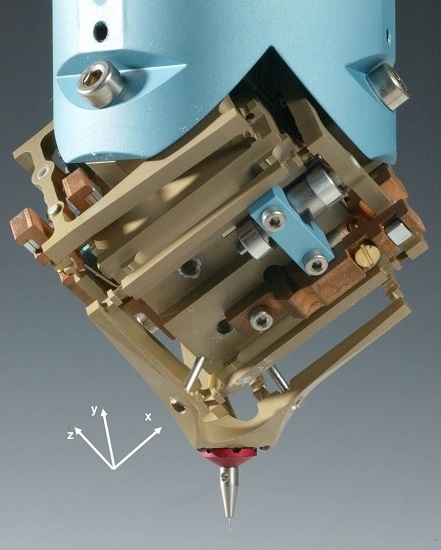State of the Art of Tactile Micro Coordinate Metrology
Abstract
:1. Introduction
2. Probe Developments
3. Stage and Metrology Systems Design
4. System Calibration and Performance Verification
4.1. Probe Calibration
4.1.1. Single Point Probing
4.1.2. Scanning
4.1.3. Probe Sphere Diameter and Form Correction
4.2. Stage Calibration and Error Correction
4.3. Performance Tests
5. Challenges for Further Development
5.1. Accessibility of 3D Features
5.2. Probe/Surface Interaction
5.3. Task Specific Uncertainty
5.4. Application in Industry
6. State of the Art and Conclusions
Acknowledgments
Author Contributions
Conflicts of Interest
Abbreviations
| CMM | Coordinate measuring machine |
| 3D | Three dimensional |
References
- Weckenmann, A.; Estler, T.; Peggs, G.; McMurtry, D. Probing systems in dimensional metrology. Ann. CIRP 2004, 53, 657–684. [Google Scholar] [CrossRef]
- Bos, E.J.C. Aspects of tactile probing on the micro scale. Precis. Eng. 2011, 35, 228–240. [Google Scholar] [CrossRef]
- Claverley, J.D.; Leach, R.K. A review of the existing performance verification infrastructure for micro-CMMs. Precis. Eng. 2014, 39, 1–15. [Google Scholar] [CrossRef]
- Küng, A.; Meli, F.; Thalmann, R. Ultraprecision micro-CMM using a low force 3D touch probe. Meas. Sci. Technol. 2007, 18, 319–327. [Google Scholar] [CrossRef]
- Guilun, J.; Schwenke, H.; Trapet, E. Opto-tactile sensor for measuring small structures on coordinate measuring machines. Proc. ASPE 1998, 18, 25–28. [Google Scholar]
- Werth 3D Fibre Probe. Available online: http://www.werth.de/index.php?id=262&L=1 (accessed on 26 April 2016).
- Buetefisch, S.; Dai, G.; Danzebrink, H.-U.; Koenders, L.; Solzbacher, F.; Orthner, M.P. Novel design for an ultra high precision 3D micro probe for CMM applications. Procedia Eng. 2010, 5, 705–712. [Google Scholar] [CrossRef]
- Bergmans, R.H.; Nieuwenkamp, H.J.; van Veghel, M.G.A. Probing behavior of a microCMM. In Proceedings of the 11th Euspen International Conference, Como, Italy, 23–26 May 2011; Volume 1, pp. 104–107.
- Peggs, G.N.; Lewis, A.; Oldfield, S. Design of a compact high-accuracy CMM. Ann. CIRP 1999, 48, 417–420. [Google Scholar] [CrossRef]
- IBS Precision Engineering. Available online: http://www.ibspe.com/category/isara-400-3d-cmm/triskelion-touch-probe.htm (accessed on 26 April 2016).
- Claverley, J.K.; Leach, R.K. Development of a three-dimensional vibrating tactile probe for miniature CCMs. Precis. Eng. 2013, 37, 491–499. [Google Scholar] [CrossRef]
- Haitjema, H.; Pril, W.O.; Schellekens, P.H.J. Development of a silicon-based nanoprobe system for 3-D measurements. Ann. CIRP 2001, 50, 365–368. [Google Scholar] [CrossRef]
- XPRESS Precision Engineering B.V. Available online: http://www.xpresspe.com/probe2.php (accessed on 26 April 2016).
- Mitutoyo. Available online: http://www.mitutoyo.co.jp/eng/new/news/2002/02_13.html (accessed on 26 April 2016).
- Alblalaihid, K.; Kinnell, P.; Lawes, S.; Desgaches, D.; Leach, R. Performance Assessment of a New Variable Stiffness Probing System for Micro-CMMs. Sensors 2016, 16, 492. [Google Scholar] [CrossRef] [PubMed] [Green Version]
- Fan, K.C.; Cheng, F.; Wang, W.; Chen, Y.; Lin, J.Y. A scanning contact probe for a micro-coordinate measuring machine (CMM). Meas. Sci. Technol. 2010, 21, 054002. [Google Scholar] [CrossRef]
- Li, R.J.; Fan, K.C.; Miao, J.W.; Huang, Q.X.; Tao, S.; Gong, E.R. An analogue contact probe using a compact 3D optical sensor for micro/nano coordinate measuring machines. Meas. Sci. Technol. 2014, 25, 094008. [Google Scholar] [CrossRef]
- Li, R.J.; Fan, K.C.; Huang, Q.X.; Zhou, H.; Gong, E.R.; Xiang, M. A long-stroke 3D contact scanning probe for micro/nano coordinate measuring machine. Precis. Eng. 2016, 43, 220–229. [Google Scholar] [CrossRef]
- Liu, F.F.; Chen, L.J.; Wang, J.F.; Xia, H.J.; Li, R.J.; Yu, L.D.; Fei, Y. Modeling and prototyping of a fiber Bragg grating-based dynamic micro-coordinate measuring machine probe. Meas. Sci. Technol. 2016, 27, 025016. [Google Scholar] [CrossRef]
- Murakami, H.; Katsuki, A.; Sajima, T.; Suematsu, T. Study of a vibrating fiber probing system for 3-D micro-structures: Performance improvement. Meas. Sci. Technol. 2014, 25, 094010. [Google Scholar] [CrossRef]
- Meli, F.; Fracheboud, M.; Bottinelli, S.; Bieri, M.; Thalmann, R.; Breguet, J.-M.; Clavel, R. High precision, low force 3D touch probe for measurements on small objects. In Proceedings of the Euspen International Topical Conference, Aachen, Germany, May 2003; pp. 411–414.
- Vermeulen, M.M.P.A.; Rosielle, P.C.J.N.; Schellekens, P.H.J. Design of a high-precision 3D-coordinate measuring machine. Ann. CIRP 1998, 47, 447–450. [Google Scholar] [CrossRef]
- Van Riel, M.; Moers, T. Nanometer uncertainty for a micro price. Mikroniek 2010, 50, 13–17. [Google Scholar]
- Jäger, G.; Manske, E.; Hausotte, T.; Buchner, H.-J. The metrological basis and operation of nanopositioning and nanomeasuring machine. Tech. Mess. 2009, 76, 227–234. [Google Scholar] [CrossRef]
- SIOS Meßtechnik GmbH. Available online: http://www.sios-de.com/?page_id=635 (accessed on 26 April 2016).
- Fan, K.C.; Fei, J.T.; Yu, X.F.; Chen, Y.J.; Wang, W.L.; Chen, F.; Liu, S.L. Development of a low-cost micro-CMM for 3D micro/nano measurements. Meas. Sci. Technol. 2006, 17, 524–532. [Google Scholar] [CrossRef]
- Huang, Q.X.; Wu, K.; Wang, C.; Li, R.J.; Fan, K.C.; Fei, J.T. Development of an Abbe Error Free Micro Coordinate Measuring Machine. Appl. Sci. 2016, 6, 97. [Google Scholar] [CrossRef]
- Ruijl, T. Ultra Precision Coordinate Measuring Machine; Design, Calibration and Error Compensation. Ph.D. Thesis, Technical University of Delft, Delft, The Netherlands, February 2001. [Google Scholar]
- Widdershoven, I.; Spaan, H.A.M. Calibration of the ISARA 400 ultra-precision CMM. In Proceedings of the First International Workshop on Advances in IT—Service Process Engineering, Guadeloupe, France, 23–28 February 2011.
- IBS Precision Engineering. Available online: http://www.ibspe.com/category/isara-400-3d-cmm.htm (accessed on 26 April 2016).
- ISO 10360-5. Geometrical Product Specifications (GPS)—Acceptance and Reverification Tests for Coordinate Measuring Machines (CMM)—Part 5: CMMs Using Single and Multiple Stylus Contacting Probing Systems; International Organization for Standardization: Geneva, Switzerland, 2010. [Google Scholar]
- Küng, A. Towards Truly 3D Metrology for Advanced Micro-Parts. EURAMET Project 1088. 2012. Available online: http://www.euramet.org/technical-committees/length/tc-l-projects/ (accessed on 26 April 2016).
- Saphirwerk. Available online: http://www.saphirwerk.com/ (accessed on 26 April 2016).
- ISO 10360-4. Geometrical Product Specifications (GPS)—Acceptance and Reverification Tests for Coordinate Measuring Machines (CMM)—Part 4: CMMs Used in Scanning Measurement Mode; International Organization for Standardization: Geneva, Switzerland, 2000. [Google Scholar]
- Küng, A.; Meli, F. Comparison of three independent calibration methods applied to an ultra-precision μ-CMM. In Proceedings of the 7th Euspen International Conference, Cranfield, UK, 20–24 May 2007; Volume 1, pp. 230–233.
- Küng, A.; Meli, F. Self calibration method for 3D roundness of spheres using an ultraprecision coordinate measuring machine. In Proceedings of the 5th Euspen International Conference, Montpellier, France, May 2005; pp. 193–196.
- Neugebauer, M. Precision size and form measurements with a micro-CMM F25. In Proceedings of the IXth International Scientific Conference Coordinate Measuring Technique, Ustroń, Poland, 14–16 April 2010.
- ISO 10360-2. Geometrical Product Specifications (GPS)—Acceptance and Reverification Tests for Coordinate Measuring Machines (CMM)—Part 2: CMMs Used for Measuring Linear Dimensions; International Organization for Standardization: Geneva, Switzerland, 2009. [Google Scholar]
- Neugebauer, M. Bilateral Comparison on Micro-CMM Artefacts between PTB and METAS; EURAMET Project 1105 Final Report 2011. Available online: http://www.euramet.org/get/?tx_stag_base%5Bfile5D=3457&tx_stag_base%5Baction%5D=downloadRaw&tx_stag_base%5Bcontroller%5D=Base (accessed on 26 April 2016).
- Küng, A.; Meli, F. Versatile probes for the METAS 3D Micro-CMM. In Proceedings of the 8th Euspen International Conference, Zürich, Switzerland, 18–22 May 2008; Volume 1, pp. 269–272.
- Küng, A.; Meli, F.; Nicolet, A. A 5 degrees of freedom μCMM. In Proceedings of the 14th Euspen International Conference, Dubrovnik, Croatia, 2–6 June 2014; Volume 1, pp. 269–272.
- Küng, A.; Nicolet, A.; Meli, F. Study of sapphire probe tip wear when scanning on different materials. Meas. Sci. Technol. 2012, 23, 094016. [Google Scholar]
- Küng, A.; Nicolet, A.; Meli, F. Study of wear of diamond-coated probe tips when scanning on different materials. Meas. Sci. Technol. 2015, 29, 084005. [Google Scholar] [CrossRef]
- ISO/TS 15530-4. Geometrical Product Specifications (GPS)—Coordinate Measuring Machines (CMM) Technique for Determining the Uncertainty of Measurement—Part 4: Evaluating Task-specific Measurement Uncertainty Using Simulation; International Organization for Standardization: Geneva, Switzerland, 2008. [Google Scholar]
- Härtig, F.; Trapet, E.; Wäldele, F.; Wiegand, U. Traceability of coordinate measurements according to the virtual CMM concept. In Proceedings of the 5th IMEKO TC-14 Symposium on Dimensional Metrology in Production and Quality Control, Zaragoza, Spain, 25–27 October 1995; pp. 245–254.
- Küng, A.; Meli, F.; Nicolet, A.; Thalmann, R. Application of a virtual coordinate measuring machine for measurement uncertainty estimation of aspherical lens parameters. Meas. Sci. Technol. 2014, 25, 094011. [Google Scholar] [CrossRef]
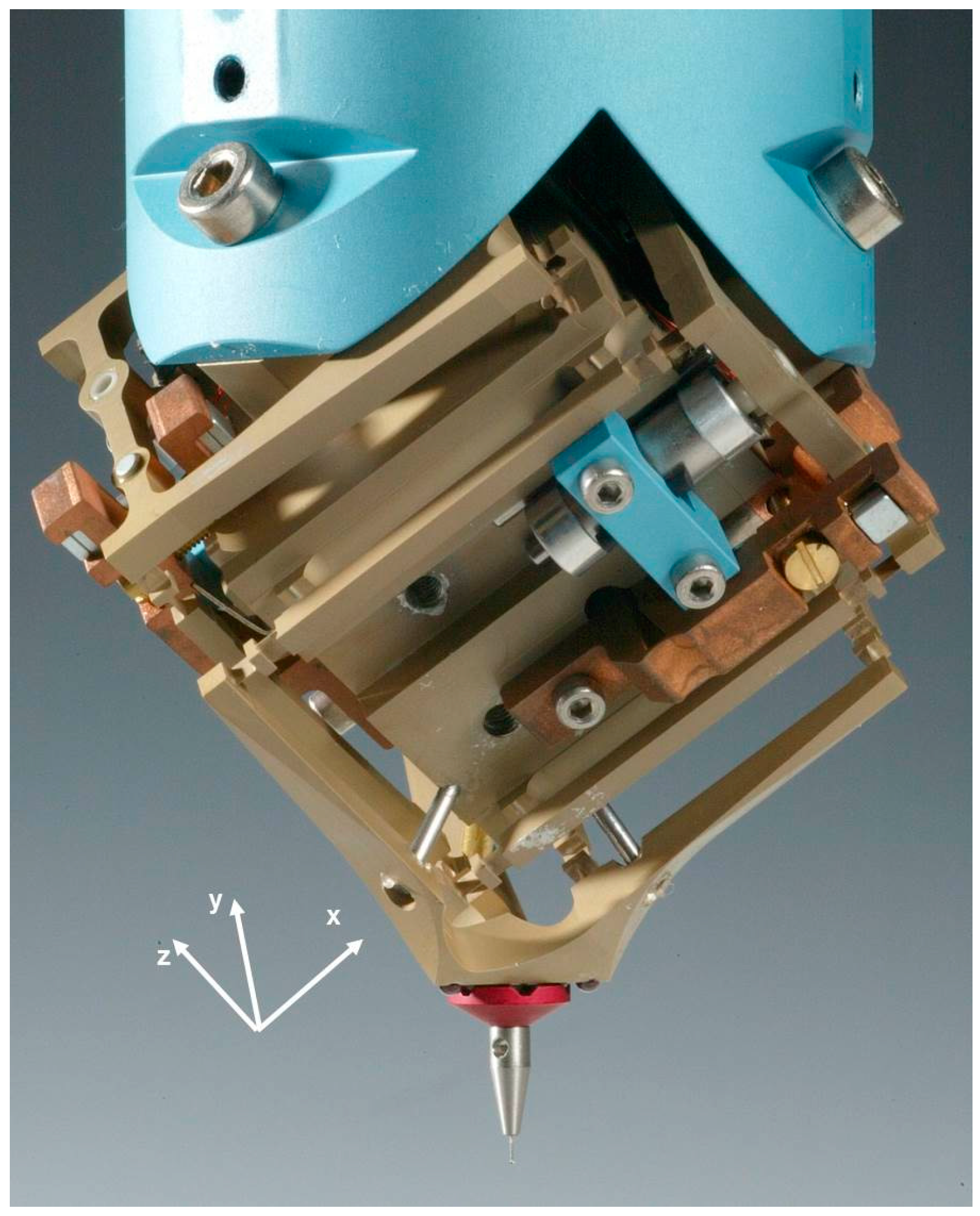
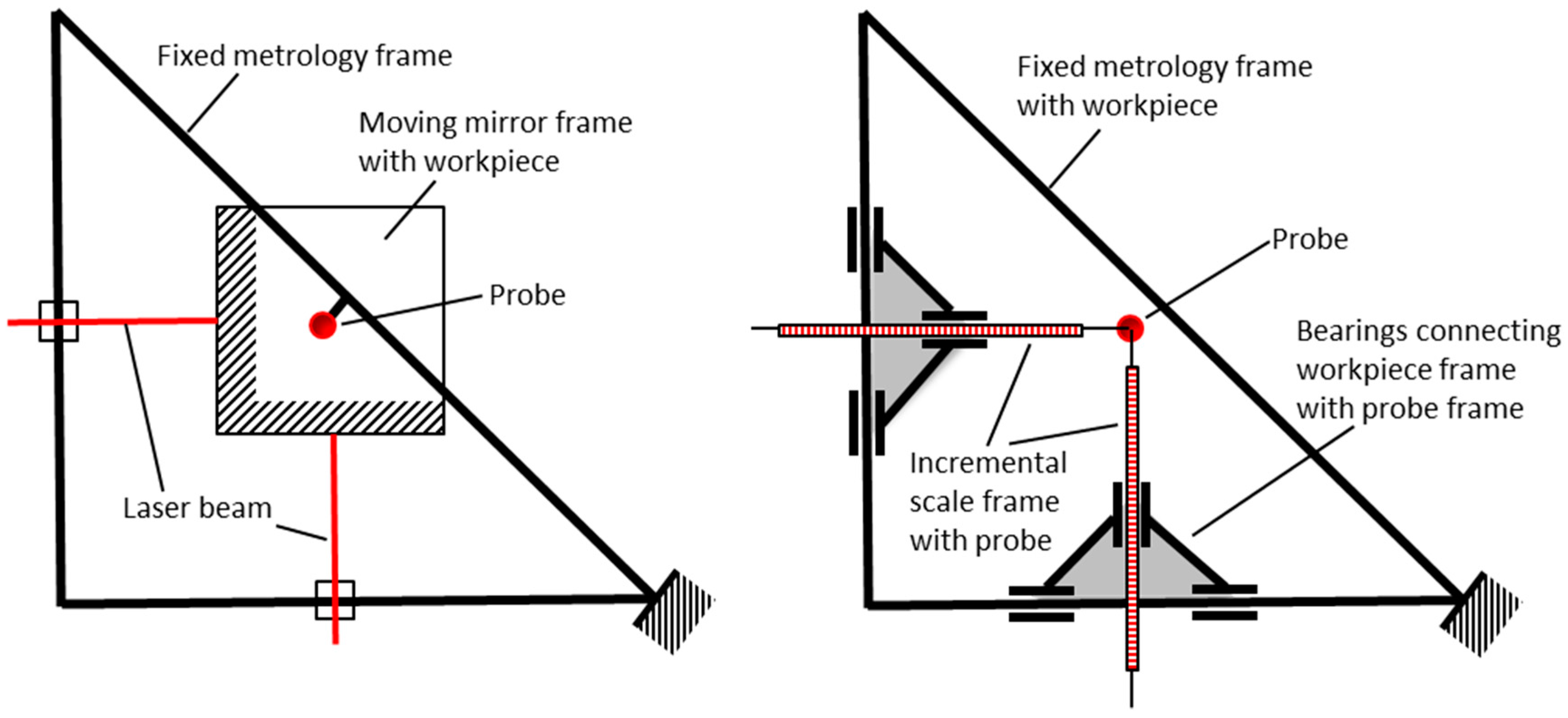
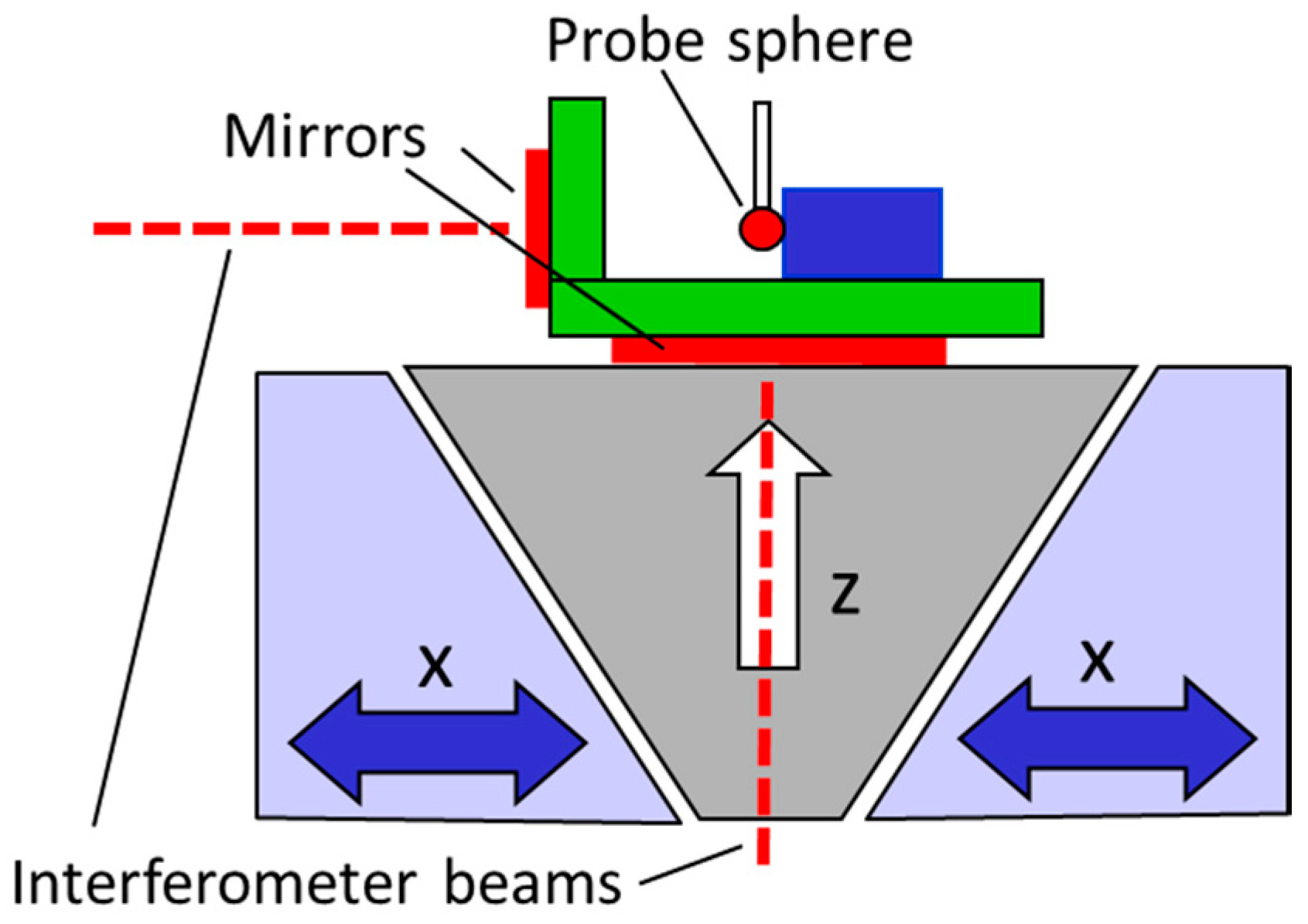
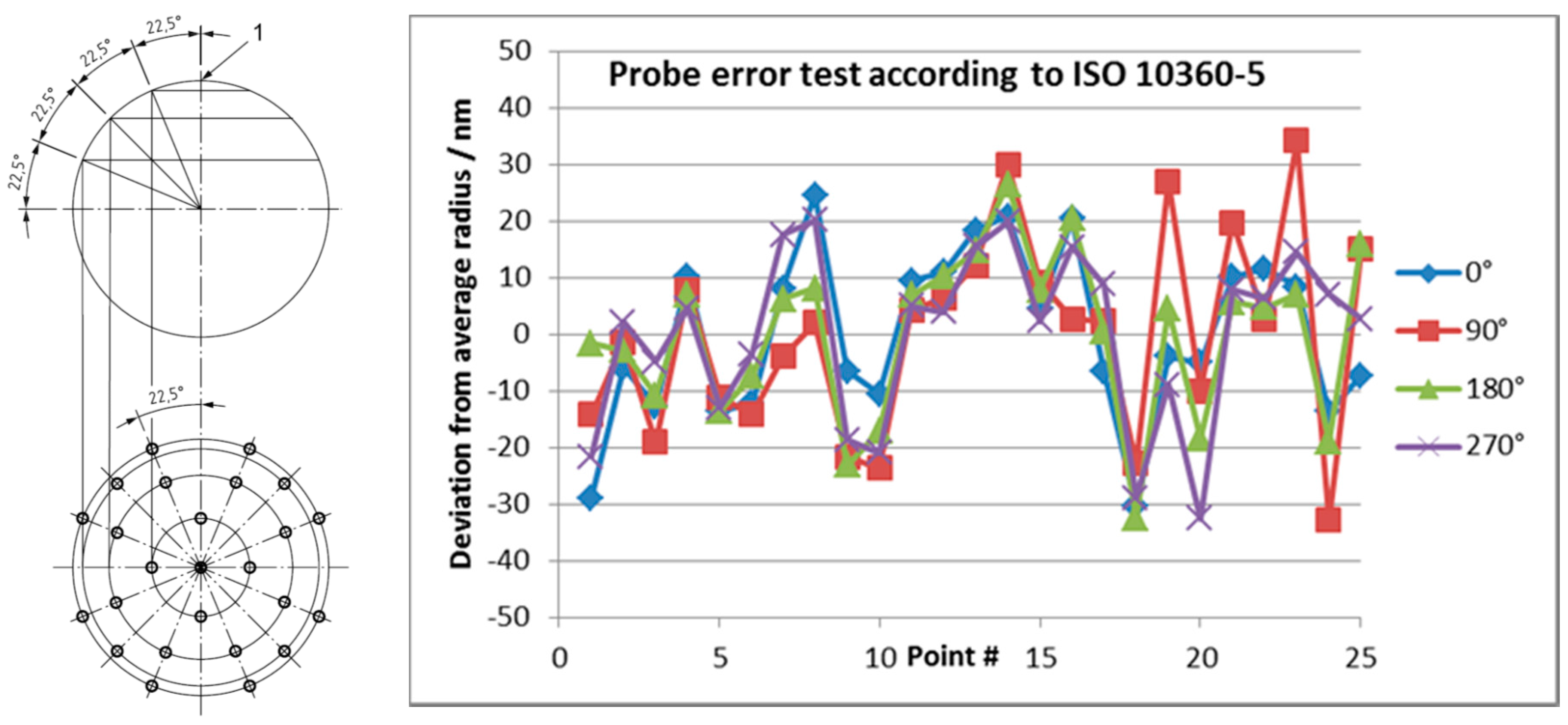
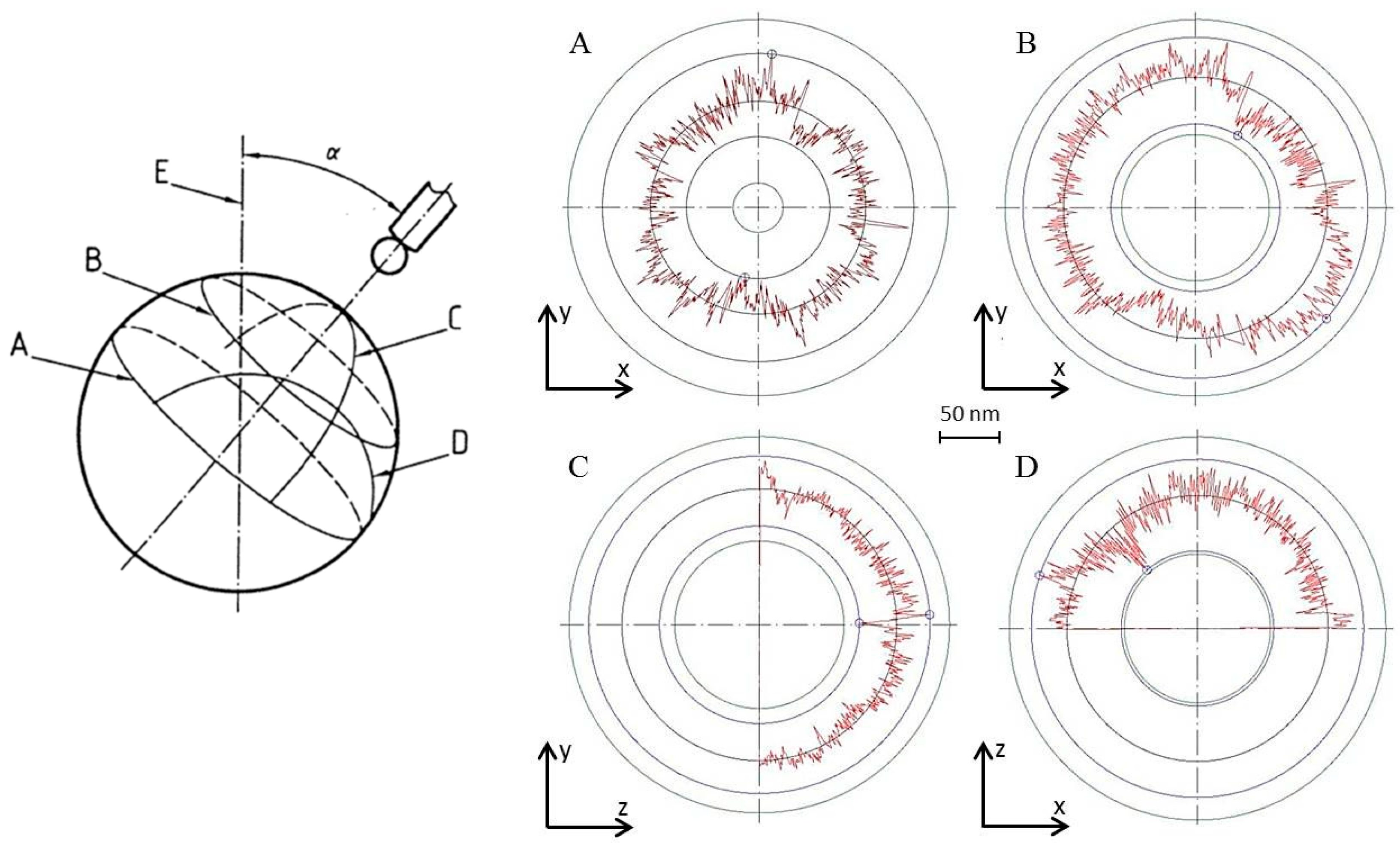
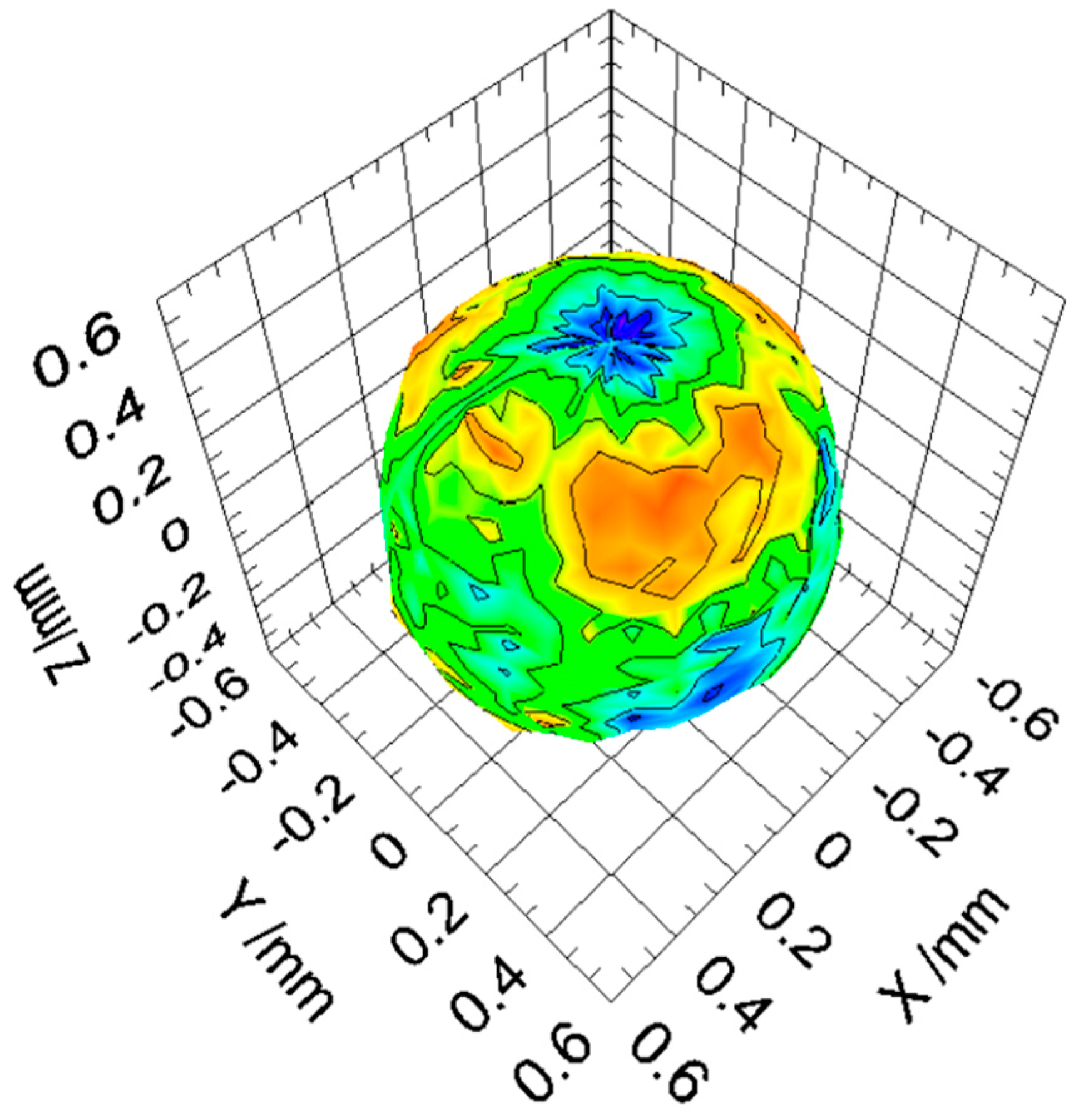

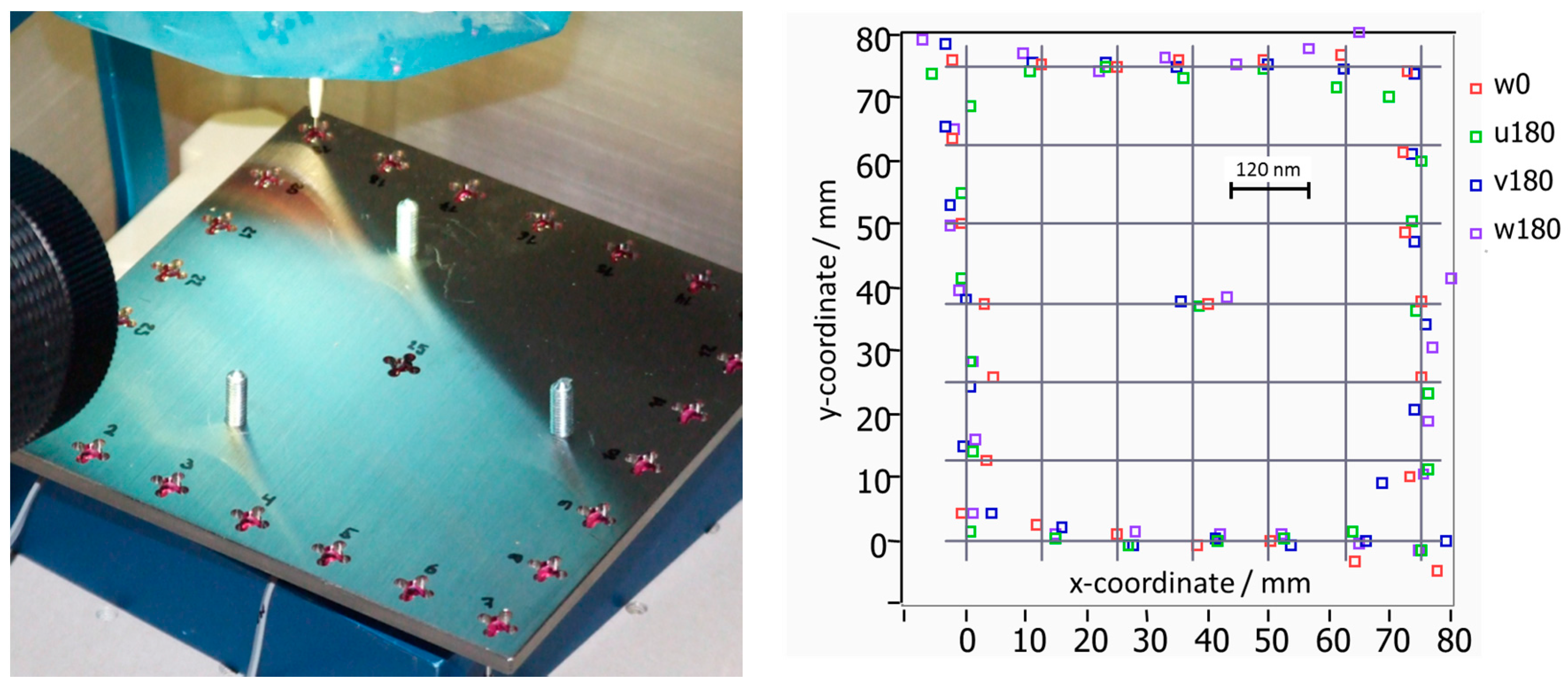
© 2016 by the authors; licensee MDPI, Basel, Switzerland. This article is an open access article distributed under the terms and conditions of the Creative Commons Attribution (CC-BY) license (http://creativecommons.org/licenses/by/4.0/).
Share and Cite
Thalmann, R.; Meli, F.; Küng, A. State of the Art of Tactile Micro Coordinate Metrology. Appl. Sci. 2016, 6, 150. https://doi.org/10.3390/app6050150
Thalmann R, Meli F, Küng A. State of the Art of Tactile Micro Coordinate Metrology. Applied Sciences. 2016; 6(5):150. https://doi.org/10.3390/app6050150
Chicago/Turabian StyleThalmann, Rudolf, Felix Meli, and Alain Küng. 2016. "State of the Art of Tactile Micro Coordinate Metrology" Applied Sciences 6, no. 5: 150. https://doi.org/10.3390/app6050150





